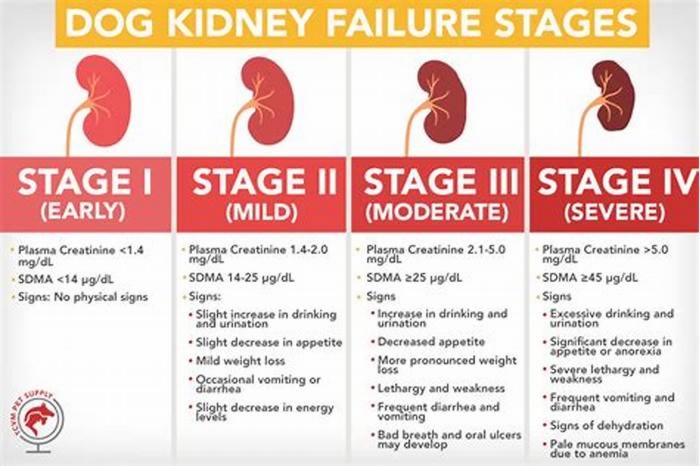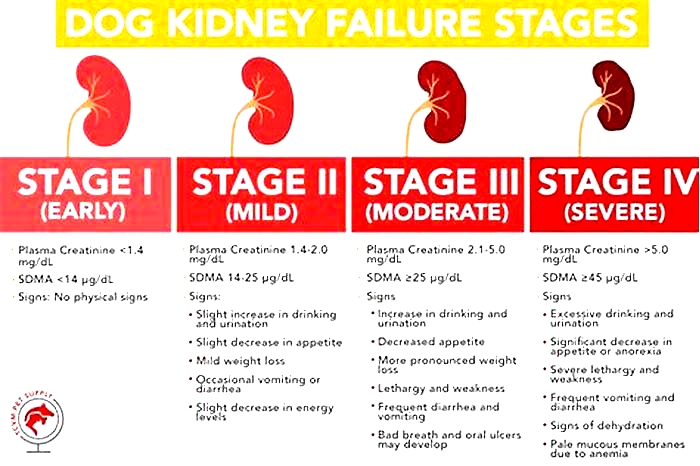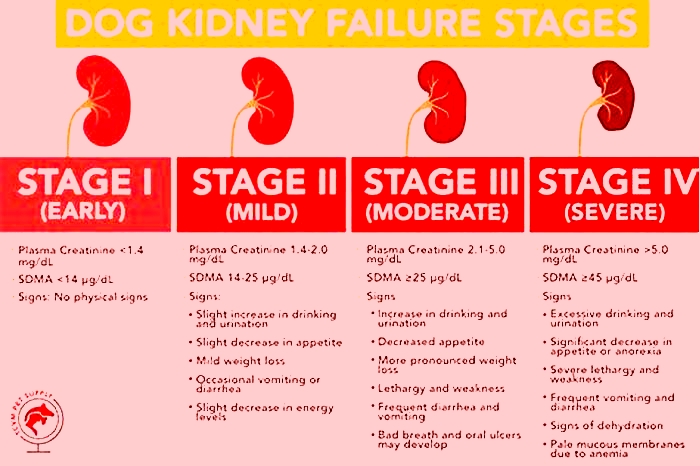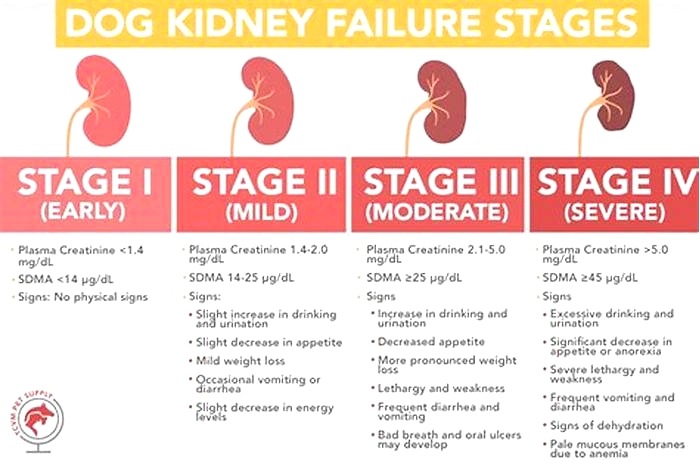seizures in dogs kidney failure

What Are the Symptoms of a Dog Dying From Kidney Failure?

If your dog has been diagnosed with this renal disease or you're worried they're showing signs associated with end-stage kidney failure, a lot is probably going through your mind right now. At the forefront might be which stage of kidney disease does your dog fall under, and how can you make them as comfortable as possible? It's advisable to educate yourself about what to expect as your pet's illness progresses. That way, you can give them the best quality of life all the way through their final days.
Dog Kidney Failure Stages
Dogs with kidney failure go through a series of four stages, from diagnosis through the eventual death of the animal. These stages do not necessarily occur within rapid succession. A dog can go through them over the course of a few months or even years. Veterinarians determine the stage your dog is in by testing the urine to look for signs of the deterioration of the kidney's functions and the blood for symmetric dimethylarginine (SDMA) levels.
The Four Stages of Kidney Failure Chart
The canine kidney failure stages are determined by the levels of creatinine and SDMA, as well as the urine-to-protein (UPC) ratio and the animal's systolic blood pressure.
| Dog Kidney Failure Stage | Creatinine (in mg/dL) | SDMA (in g/dL) |
| Stage 1 | less than 1.4 | less than 18 |
| Stage 2 | 1.4 to 2.0 | 18 to 35 |
| Stage 3 | 2.1 to 5.0 | 36 to 54 |
| Stage 4 | greater than 5.0 | greater than 54 |
Other clinical indications that a dog is in the stages of kidney failure are:
- UPC Ratio:
- Nonproteinuric: less than 0.2
- Borderline proteinuric: 0.2 to 0.5
- Proteinuric: greater than 0.5
- Systolic blood pressure (in mmHg):
- Normotensive: less than 150
- Borderline hypertensive: 150 to 159
- Hypertensive: 160 to 179
- Severely hypertensive: greater than 180
Symptoms of End-Stage Kidney Failure in Dogs
The most common signs a dog is dying from kidney failure include:
- Uremia: The buildup of waste products in the body produces a distinctive ammonia smell that is especially apparent on the breath.
- Pale, dry gums: The gums are duller and dry to the touch.
- Mouth ulcers: Uremia causes raw mouth ulcers that are painful.
- Bloodshot eyes: The whites of the eyes are bloodshot.
- Increased thirst: An affected dog drinks water excessively.
- Increased urination: The dog will urine large volumes of dilute urine.
- Dehydration: Despite more fluid intake, the dog is dehydrated.
- Decreased appetite: The dog loses interest in food.
- Weight loss: The dog steadily loses weight.
- Gradual loss of fat and muscle mass: The weight loss affects both fat and muscle mass and can cause emaciation.
- Dull coat that sheds excessively: The lackluster coat constantly sheds and looks unkempt.
- Lethargy: The dog has little energy or interest in moving around.
- Fatigue: The dog sleeps most of the day and night with only brief periods of wakefulness.
- Vomiting: The dog vomits frequently and cannot keep food down.
- Anemia: The dog may develop anemia.
- High blood pressure: The dog has elevated blood pressure.
- Incontinence: A dog cannot control their urination.
- Difficulty breathing: The dog has problems breathing normally.
- Slowing heart rate: A faster heart rate is generally present with kidney failure, but the heart rate begins to slow down during the end stage of the disease.
- Depression: The dog seems sad and does not respond to any of their favorite things.
- Low temperature: Dogs in their last days of kidney failure can experience hypothermia or a low body temperature.
- Lack of interest in surroundings: The dog is unaware of or disinterested in their surroundings.
- Disorientation: The dog acts confused at times.
- Loss of balance and coordination: The dog appears clumsy and unsteady on their feet.
- Trembling or shaking: The dog has tremors or episodes of shaking.
- Seizures: The dog suffers periodic seizures, one of the major signs of end-stage kidney failure.
Keeping Your Pet Comfortable
Watching your pet go through this can be very difficult. However, there are things you can do to help keep your dog comfortable during the final stages of kidney disease.
- Spend as much time as possible with your dog. Even being in the same room will be soothing to them.
- Make sure your dog's resting area is quiet, warm, and cozy. Provide them with their favorite blanket and toy.
- Protect your pet from other pets or people who may be too rough with them. Supervise interactions with children and teach them to be gentle with the dog.
- Pet your dog and talk to them frequently.
- Change your dog's bedding often and keep them clean and dry. Brush their fur for dry cleaning. Clean their fur with a sponge bath solution of hypoallergenic pet shampoo.
- Feed your pet a low-protein dog food appropriate for a kidney failure diet.
- If your dog refuses to eat or has trouble eating, ask the veterinarian about other feeding options such as an esophagostomy tube to keep them nourished.
- Monitor your dog's temperature and keep them warm with plenty of cozy blankets.

Last Days of a Dog Dying From Kidney Failure
While a dog owner may fear that entering the final stage of kidney failure means their dog's passing away is imminent, it is difficult to predict how long the does has left. In general, you can expect your dog to pass away within three months of moving into stage 4, though some dogs may thrive for up to a year.
It depends on the associated symptoms and other conditions that may arise due to the dog's poor health. Your dog's age is another factor. There's a lot to keep in mind, a lot to hope for, and the reality that you're facing the end of your dog's life.
Fast Fact
Controlling your dog's diet can help during their struggle with renal failure. Carefully discuss nutrition with your dog's veterinarian.
When to Consider Euthanization
When a dog enters end-stage renal failure, your veterinarian may recommend an end-of-life home treatment plan or a hospice program to make your pet's last days comfortable and maintain your pet's quality of life. For end-stage kidney failure, a treatment plan may include dialysis, a stomach tube, intravenous therapy, pain medication, and methods to care for an incontinent pet.
Depending on their symptoms, your dog may not necessarily be in severe pain, but they will be uncomfortable at the least from other symptoms, including frequent vomiting and diarrhea, lethargy and depression, and constant dehydration. Your veterinarian may recommend euthanasia if a dog is suffering, unresponsive to pain management, or too weak to handle necessary life-sustaining treatment.
Dealing With the Loss
It's hard to come to terms with the fact that a pet is dying. Find comfort in the fact that your dog appreciates your loving care in their final days. They know you love them and take comfort in your presence and all that you do to make their life easier.
2024 LoveToKnow Media. All rights reserved.
Kidney Failure And Seizures In Dogs
[ad_1]Kidney failure and seizures are two serious health issues that can affect dogs, and when they occur together, it can be especially concerning for pet owners. Kidney failure, also known as renal failure, occurs when the kidneys are no longer able to function properly and filter waste products from the blood. Seizures, on the other hand, are sudden, uncontrolled bursts of electrical activity in the brain that can cause a range of symptoms, from mild twitching to full-blown convulsions.
When a dog experiences both kidney failure and seizures, it can be a complex and challenging situation to manage. In this article, we will explore the relationship between kidney failure and seizures in dogs, including common trends, concerns, and answers related to the topic.
Trends:
1. Increased Risk with Age: Older dogs are more likely to develop kidney failure and seizures, as these conditions are often associated with the natural aging process.
2. Breed Predisposition: Certain breeds, such as Cocker Spaniels, German Shepherds, and Doberman Pinschers, may be more prone to developing kidney failure and seizures.
3. Environmental Factors: Exposure to toxins, such as antifreeze or certain medications, can increase the risk of kidney failure and seizures in dogs.
4. Underlying Health Conditions: Dogs with pre-existing health issues, such as diabetes or high blood pressure, are more susceptible to developing kidney failure and seizures.
5. Nutritional Deficiencies: Poor diet and lack of essential nutrients can contribute to kidney failure and seizures in dogs.
6. Medication Side Effects: Some medications used to treat other health conditions can have adverse effects on the kidneys and brain, leading to seizures.
7. Genetic Factors: In some cases, genetic predisposition can play a role in the development of kidney failure and seizures in dogs.
Quotes from Professionals:
1. Managing kidney failure and seizures in dogs requires a comprehensive approach that addresses both the underlying causes and the symptoms. Its important to work closely with your veterinarian to develop a treatment plan that is tailored to your dogs individual needs. Veterinarian
2. Nutrition plays a key role in supporting kidney function and overall health in dogs with kidney failure and seizures. A diet that is low in phosphorus and high in quality protein can help to reduce the strain on the kidneys and minimize the risk of seizures. Veterinary Nutritionist
3. Seizures in dogs with kidney failure can be particularly challenging to control, as the underlying kidney disease can complicate the management of epilepsy. Its essential to monitor your dog closely and report any changes in seizure activity to your veterinarian. Veterinary Neurologist
4. Regular monitoring of kidney function through blood tests and urine analysis is crucial for dogs with kidney failure and seizures. Early detection of changes in kidney function can help to guide treatment decisions and improve the long-term prognosis. Veterinary Internal Medicine Specialist
Common Concerns and Answers:
1. Can kidney failure cause seizures in dogs?
Yes, kidney failure can lead to electrolyte imbalances, high blood pressure, and toxins build-up in the body, which can trigger seizures in dogs.
2. How are kidney failure and seizures diagnosed in dogs?
Diagnosis of kidney failure and seizures in dogs typically involves blood tests, urine analysis, imaging studies, and neurological examinations.
3. What are the treatment options for kidney failure and seizures in dogs?
Treatment may include medications to control seizures, dietary management, fluid therapy, and in severe cases, dialysis or kidney transplantation.
4. Can kidney failure and seizures be prevented in dogs?
While some factors, such as age and genetics, cannot be controlled, maintaining a healthy diet, regular exercise, and preventive veterinary care can help reduce the risk of kidney failure and seizures.
5. Are seizures in dogs with kidney failure life-threatening?
Seizures can be life-threatening if not properly managed, especially in dogs with underlying kidney disease. Its essential to seek prompt veterinary care if your dog experiences seizures.
6. How can I support my dog with kidney failure and seizures at home?
Provide a quiet and safe environment for your dog, monitor their water intake and urine output, and follow your veterinarians recommendations for medication and dietary management.
7. Can kidney failure and seizures be cured in dogs?
While there is no cure for kidney failure or seizures, with proper management and treatment, many dogs can lead a good quality of life despite these conditions.
8. Are there any alternative therapies that can help dogs with kidney failure and seizures?
Some pet owners may explore alternative treatments, such as acupuncture or herbal supplements, but its essential to consult with a veterinarian before trying any alternative therapies.
9. How often should a dog with kidney failure and seizures see the veterinarian?
Regular veterinary check-ups are crucial for monitoring your dogs condition and adjusting treatment as needed. Your veterinarian will recommend a schedule based on your dogs individual needs.
10. Can stress trigger seizures in dogs with kidney failure?
Stress can be a trigger for seizures in some dogs, so its important to create a calm and predictable environment for your pet to help reduce the risk of seizure activity.
11. Are there any warning signs that my dogs kidney failure is worsening?
Signs of worsening kidney failure may include increased thirst and urination, decreased appetite, weight loss, lethargy, and changes in behavior. Contact your veterinarian if you notice any of these symptoms.
12. Should I restrict my dogs activity if they have kidney failure and seizures?
Moderate exercise is beneficial for dogs with kidney failure, but its essential to avoid strenuous activity that could increase the risk of seizures. Consult with your veterinarian for guidance on an appropriate exercise plan.
13. Can medications for seizures affect kidney function in dogs?
Some medications used to control seizures can have side effects on the kidneys, so its important to work closely with your veterinarian to monitor your dogs kidney function while on these medications.
14. How can I help my dog feel more comfortable during a seizure?
During a seizure, its important to remain calm and ensure your dog is in a safe place. Avoid touching your dogs mouth or head and speak softly to provide reassurance until the seizure passes.
15. What is the prognosis for dogs with kidney failure and seizures?
The prognosis for dogs with kidney failure and seizures can vary depending on the underlying causes, the severity of the conditions, and how well they respond to treatment. With proper care and management, many dogs can live a good quality of life despite these challenges.
In conclusion, kidney failure and seizures in dogs are complex conditions that require careful management and monitoring to ensure the best possible outcomes for our furry friends. By staying informed, working closely with veterinary professionals, and providing loving care and support, pet owners can help their dogs navigate these health challenges with resilience and grace. Remember, your veterinarian is your best ally in the fight against kidney failure and seizures, so dont hesitate to reach out for guidance and support along the way.[ad_2]








